When asked if China is an enemy, competitor or partner of the U.S., most Americans say China is a competitor. Even so, Americans most frequently name China as the country posing the top threat to the U.S.
Additionally, a majority of Americans say that tensions in China’s relationship with Taiwan are important to U.S. national interests.
Is China a partner, competitor or enemy of the U.S.?
A majority of Americans (56%) say China is a competitor of the U.S., as opposed to an enemy (33%) or a partner (9%).
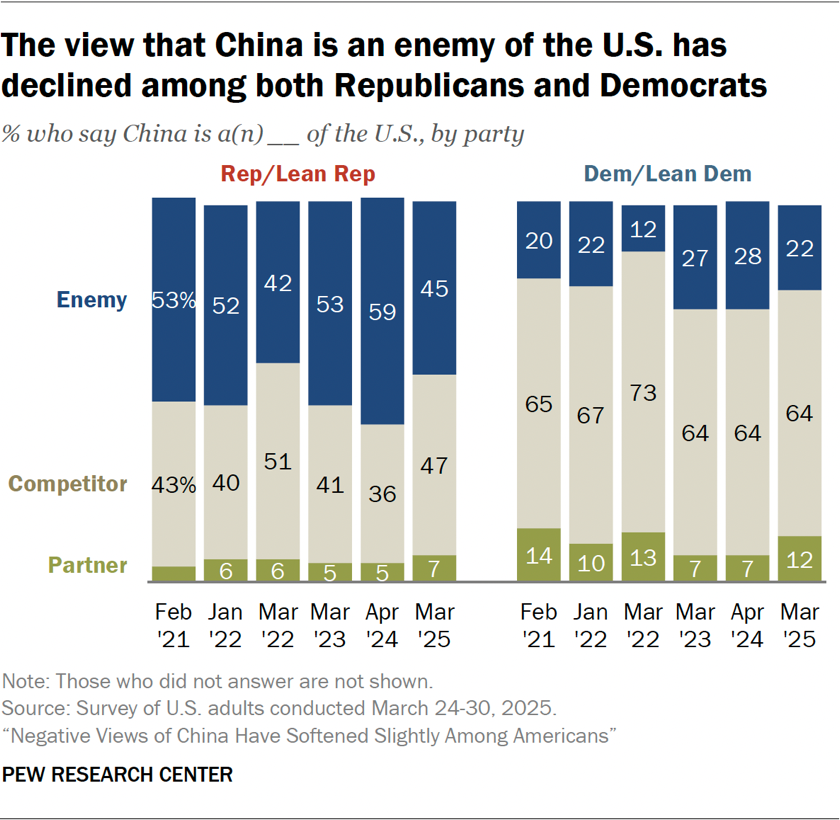
For the first time since 2022, the share of people describing China as an enemy has fallen from the year before. In this case, the share has fallen 9 points since April 2024.
Views by party
Republicans and Republican-leaning independents are about twice as likely as Democrats and Democratic leaners to describe China as an enemy (45% vs. 22%).
But the share of Republicans describing China as an enemy has fallen 14 points since last year. Now, relatively equal shares of Republicans describe China as a competitor (47%) and an enemy (45%).
Democrats, too, are less likely to call China an enemy now than they were last year, though the shift has been more muted (22%, down from 28%). Democrats are also slightly more likely to describe China as a partner now than last year (12%, up from 7%).
Views by age
Older Americans are much more likely than younger adults to call China an enemy: 47% of those ages 65 and older hold this view, compared with 40% of those ages 50 to 64, 26% of those 30 to 49 and 19% of those 18 to 29. In comparison, younger Americans are most likely to see China as a competitor: 61% of adults under 30 say this, though some call China a partner (19%) or an enemy (19%).
China as a threat to the U.S.
When asked in an open-ended question which country poses the greatest threat to the U.S., 42% of Americans name China. Another 25% name Russia, and 20% say they are not sure. Still others name the U.S. itself (3%), Iran (2%), North Korea (1%) or Israel (1%).
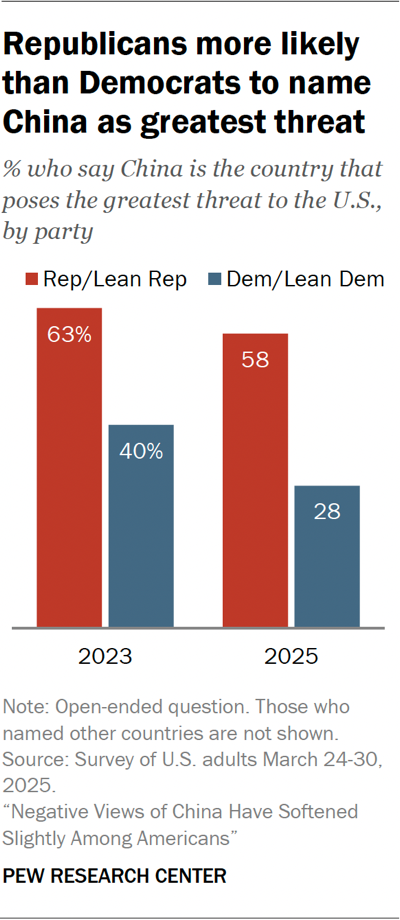
China was also considered the country posing the greatest threat in 2023, when the question was last asked. At that time, half the U.S. public held this view.
Views by party
Republicans are more likely than Democrats to name China as the country that poses the greatest threat to the U.S. (58% vs. 28%). This view is particularly common among conservative Republicans, who are 23 points more likely than their moderate and liberal counterparts to hold this view (68% vs. 45%). Conservative and moderate Democrats are 6 points more likely than liberal Democrats to consider China the top threat to the U.S. (31% vs. 25%).
Supporters of both parties have become less likely to name China as the country that poses the greatest threat to the U.S., but the decline has been particularly steep among Democrats. Democrats are 12 points less likely than in 2023 to name China as the top threat. In fact, the largest share of Democrats now name Russia, not China, as the country posing the greatest threat to the U.S. (39%).
Republicans have also become less likely to name China as the top threat, but to a lesser extent (-5 points).
What type of threat does China pose to the U.S.?
Of those who named China as the country posing the greatest threat to the U.S., most agree China poses at least a fair amount of threat to the U.S. economy and to its national security.
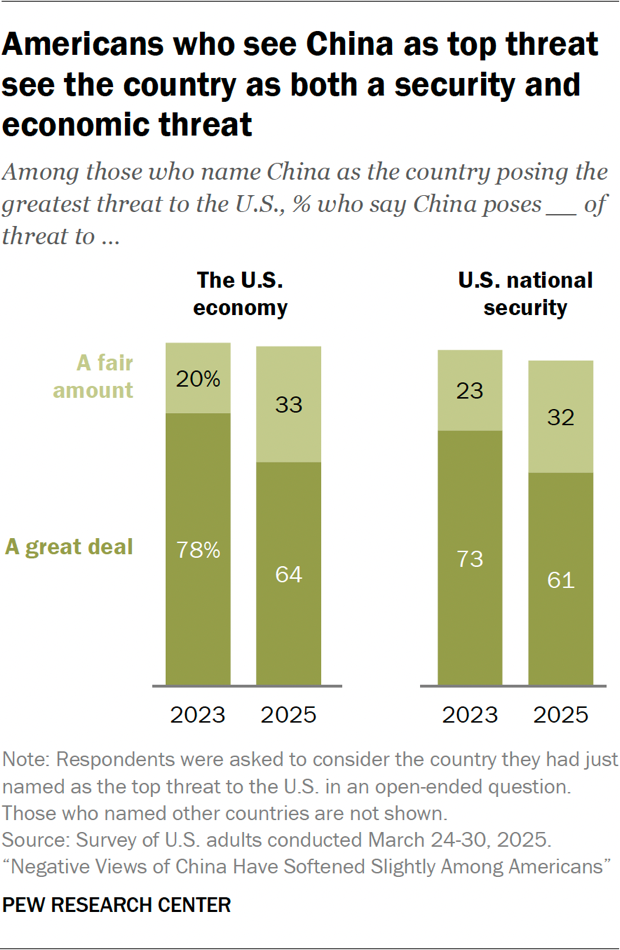
These assessments are somewhat tempered from 2023. Since then, Americans who say China is the country posing the greatest threat to the U.S. have become 14 points less likely to say China poses a great deal of threat to the U.S. economy and 12 points less likely to say the same of China as a threat to U.S. national security.
Views by age
Older Americans who see China as the top threat to the U.S. are more inclined than their younger counterparts to consider China a major threat to national security. Of those ages 65 and older, 70% say China poses a great deal of threat to national security. In comparison, 46% of adults under 30 agree.
Older and younger Americans who name China as the top threat to the U.S. largely agree in their assessments of China as an economic threat.
Views by party
Republicans are especially inclined to see China as a major threat to national security: 65% of Republicans who consider China as the greatest threat to the U.S. hold this view, compared with 55% of their Democratic counterparts.
Among those who see China as the country posing the greatest threat to the U.S., Republicans and Democrats share similar views of China as a threat to the U.S. economy.
Tensions between China and Taiwan
Roughly two-thirds of Americans (66%) say tensions between China and Taiwan are important to U.S. national interests, including 31% who think the issue is very important. Additionally, 47% say cross-strait tensions are personally important to them.
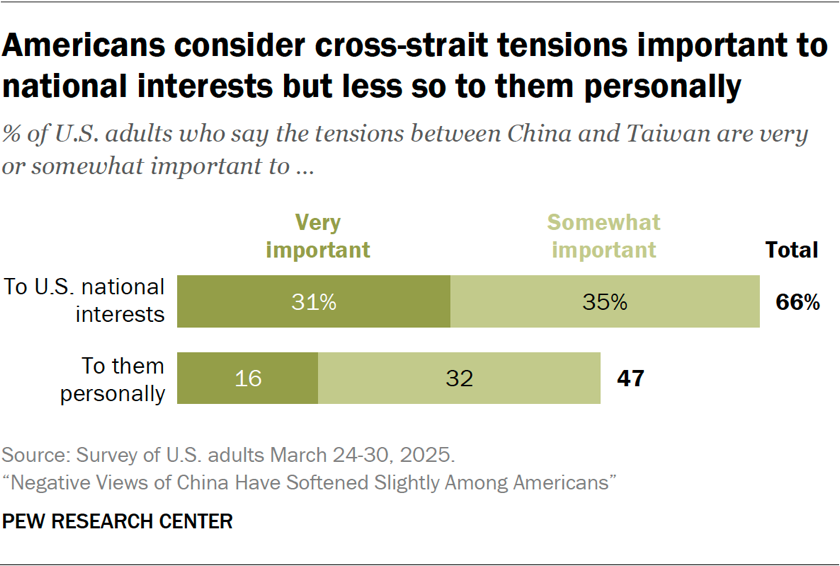
By way of comparison, similar shares of Americans describe China-Taiwan tensions as important to national interests as say the same of the Israel-Hamas war (66%) and the Russia-Ukraine war (69%). However, fewer say it’s personally important to them than say this of the other two conflicts.
The issue’s importance among Americans has also declined over the last year. Compared with 2024, Americans are 9 points less likely to consider tensions between China and Taiwan important to national interests and 10 points less likely to consider the tensions important to them personally.
For more on Americans’ views of the Israel-Hamas war, read “How Americans view Israel and the Israel-Hamas war at the start of Trump’s second term.” And for more on American views of the Russia-Ukraine war, read “Republican Opinion Shifts on Russia-Ukraine War.”
Views by age
Older Americans are more likely than younger Americans to see cross-strait tensions as important to national interests and to them personally. Among those ages 65 and older, 78% consider the issue important to national interests, compared with 55% of those ages 18 to 29. Likewise, 65% of those 65 and older see tensions between China and Taiwan as important to them personally, compared with 36% of adults under 30.
Views by education
Americans with more education place greater importance on the tensions between China and Taiwan. Those with at least a four-year college degree are 19 points more likely than those without to consider cross-strait tensions important to U.S. interests (79% vs. 60%) and 13 points more likely to say these tensions are important to them personally (56% vs. 43%).
Views by party
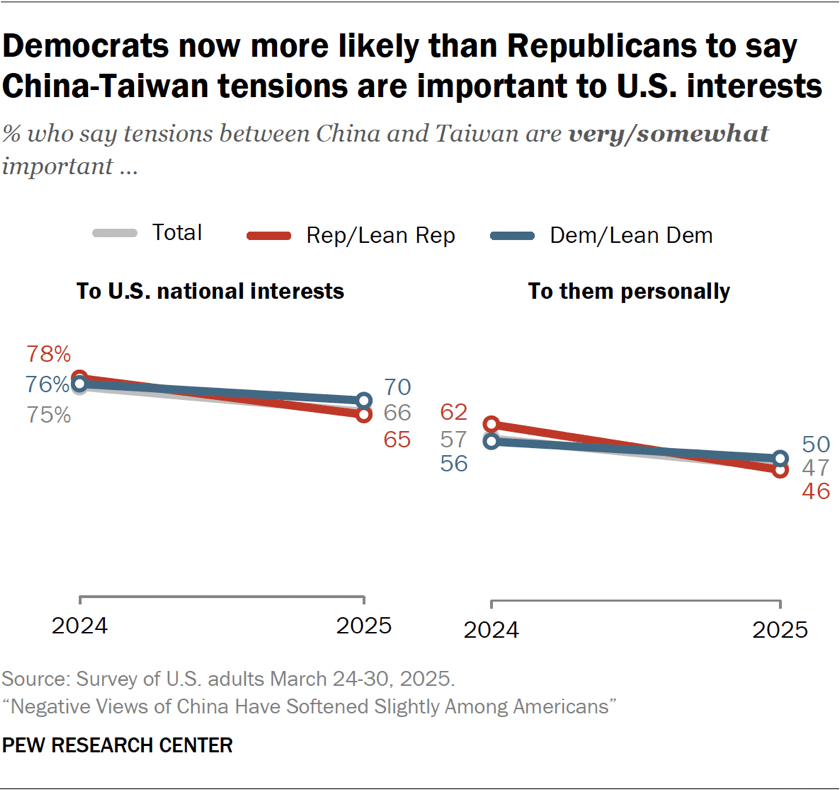
Democrats are more likely than Republicans to see tensions between China and Taiwan as important to U.S. national interests. However, Democrats and Republicans aresimilarly likely to consider cross-strait tensions personally important.
This is a reversal from last year, when supporters of each party were equally likely to consider tensions important to national interests, and Republicans were more likely to consider them personally important.




